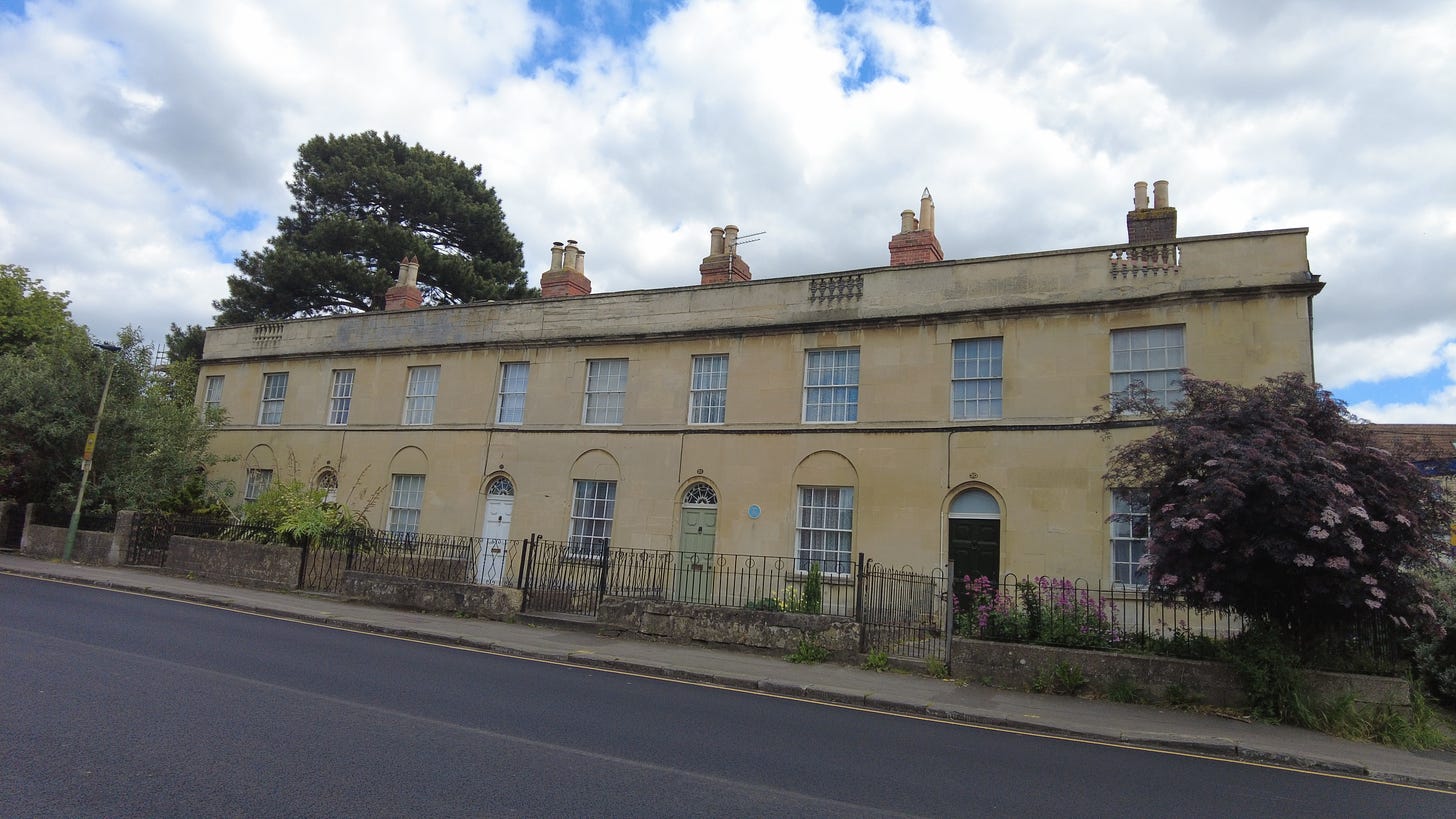We often take for credit the places where we live, and right on our own doorstep is a rich heritage. I live in the County Town of Wiltshire, Trowbridge. Over recent decades it has dramatically expanded, as have so many other towns. Yes, it has many housing estates, which can be viewed as the same repetitive little boxes as elsewhere. However, there are many historic buildings within the town, each with its own story.
Trowbridge has many, and some have been given a Blue Plaque to indicate to passersby that there is at least one story that this building holds. Let’s take a look at these in this post.
We commence with 46 Fore Street, Trowbridge, now the HSBC Bank. This was a grand house (many shops started life as homes) and was the home of John Watts. The building was constructed in the early 18th century. John is described on the Blue Plaque as a ‘Retired Portugal Trader’ and died in 1741.
Standing next to John Watt’s former home is our next building bearing Blue Plaque, the former George Hotel. The plaque has these words written on it:
The George Hotel
Stood on this site. A tavern was here in 1349 and called The George by 1467. It was one of the principal hotels until it closed in 1981.
Facade 1860.
There are still two more Blue Plaques in Fore Street, and we next look at the building occupied by Lloyds Bank. This is number 64 Fore Street. The plaque tells us:
Built for Thomas Cooper, clothier c1700.
Wiltshire and Dorset Bank 1866.
Lloyds Bank 1914.
Trowbridge was a woollen town, and therefore many of the finest properties in the town and surrounding villages have been built on the wealth it generated. This property has been a Lloyds Bank since 1914 and, prior to that, the Wiltshire and Dorset Bank. As you look at the building, you can soon tell that it was once a grand house. It was built for Thomas Cooper around 1700. Thomas made his fortune as a clothier.
Finally, in Fore Street, we come to 66/67. All these buildings are within a short distance of each other, and looking out from the front door, Thomas Cooper had a daily view of this one. 67/67 existed long before Thomas had his house built, and this home has royal connections.
The Blue Plaque informs us:
A late-Tudor timber-framed house refronted c.1700.
Mary Langford, great-grandmother of Queen Mary II and Queen Ann,born here 1597.
Who would have known were it not for the sign on the side wall of this property?
We can now move a short walk away to 31 Union Street and find the former home of John Warburton.
The Blue Plaque states:
JOHN WARBURTON
minister of the Zion Baptist Chapel and author of The Mercies of a Covenant God
Lived here 1832-1850.
History tells us that John first preached in Trowbridge on 27th January 1814, and extended this to preach each Sunday in February that year. The new church at Zion invited John Warburton to return to preach in February 1815, and at the end of that month, an invitation to become their pastor was extended to him. The church book records that on 5th March John Warburton “accepted the call of the church to be its Pastor for as long as the majority, and he shall agree”.
Next, we travel a little further out of the town centre and come to Highfield, now known as Fieldways Hotel and Health Club.
This time our Blue Plaque states:
HIGHFIELD
Sir William Roger Brown JP 1831 - 1902
Clothier and benefactor lived here. He gave Trowbridge its Town Hall and the Lady Brown's Cottage Homes Almhouses
The house was built in 1859 by William Roger Brown. It was so named because of the view over the back field on higher ground. William Roger Brown was an important character here in Trowbridge and one of the town’s principal benefactors. He was born in Bath in 1831; although the son of a tea dealer, Roger was more interested in the cloth trade. Trowbridge was the main centre of the cloth trade, and in time he became a prosperous and wealthy man.
Trowbridge’s Military Past
Our final Blue Plaque is not a building but a wall. There are two sections of the wall remaining from Trowbridge Barracks.
Our Blue Plaque sign informs us:
Trowbridge Barracks
1793 Demolished in 1961.
One of two remaining sections of the Trowbridge Barracks wall, this was part of the eastern wall of the barracks.

118 Field Battery from 26 Brigade RFA were stationed at Trowbridge Barracks in March 1902.
During the Great War, it was the home of No: 1 Officer Cadet School, RGA. The War Poet Edward Thomas was stationed here in 1916 he was killed in 1917 in France.
I hope you have enjoyed this tour of the current Blue Plaque sites that are in Trowbridge. In the future, I hope to delve deeper into some of those who are commemorated in these plaques. If you’re not a subscriber yet, please do consider subscribing now and each new post will be sent to your inbox.
If you would like to share this post with those you know or your social media followers, please click the share button. Thank you.













Interesting read that Roland, a lot of history there.